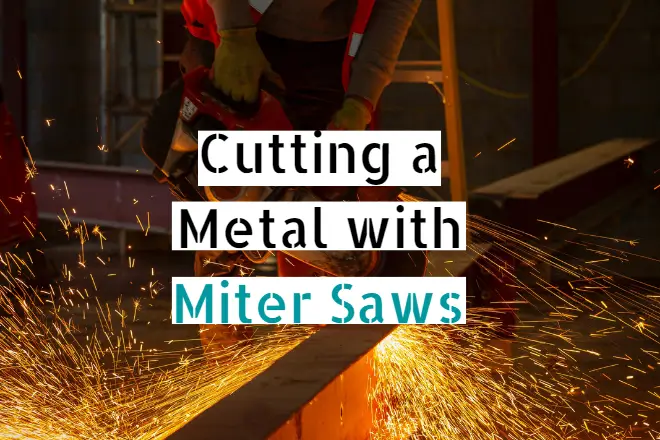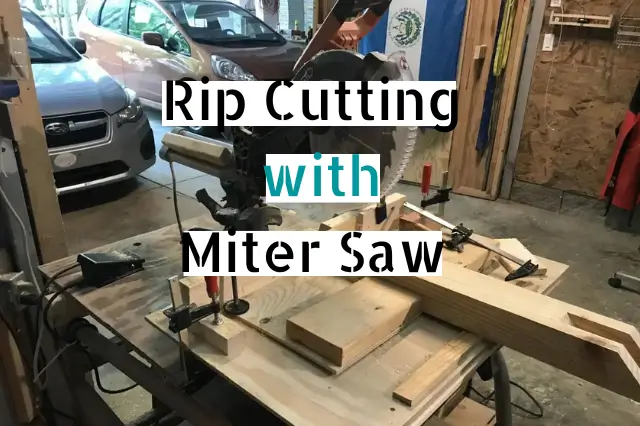Welcome to our blog, where we explore the mysteries of miter saws and answer questions like “can miter saws cut metal”?
Let’s clarify one common misconception about miter saws before we get started. Contrary to popular belief, miter saws are not exclusively used for woodworking!
Miter saws have a reputation for being versatile tools, but not all miter saws are the same. While some models may be able to cut metal due to their higher power, not all miter saws can cut metal. Many consumers think miter saws can cut any material, including metal, but this is simply not the case.
To answer the question of whether or not miter saws can cut metal, it’s important to know what types of miter saw there are and how they work.
Let’s dig into the main topic in detail!
What is a Miter Saw?
A miter saw is a tool for making precise crosscuts and miter cuts (angled or oblique cuts, usually in the range of 45 to 90 degrees) in a variety of materials such as wood, metal, and plastic. It consists of a circular saw blade mounted on an arm that can be moved up and down. This arm is attached to a base that sits on a flat surface, allowing the user to make precise and accurate angled cuts.
Most miter saws have a swiveling feature so that they can make compound angle cuts. They also come with different types of blades depending on the type of material being cut. For example, if you want to cut wood, you would use an ATB (Alternative Top Bevel) blade.
If you want to cut metal, then you need to use an ATBR (Alternative Top Bevel Rake) blade or an MTCG (Multi-tooth Carbide Grit) blade with specific speeds depending on the hardness of the material being cut.
Types of Miter Saws
Understanding the different types of miter saws available will help you select the right tool for your project. Some popular options include:
1. Compound Miter Saw
This type of miter saw can make bevel and miter cuts, both of which come in handy when creating moldings and trim pieces. The angle and length of the cut can be adjusted, allowing users to make intricate design cuts as needed.
2. Dual Compound Miter Saw
An upgraded version of the compound miter saw model has dual action blades with one spinning clockwise and another counter-clockwise, allowing users to achieve even more precise angled cuts and perfect trimming or molding pieces quickly and easily.
3. Sliding Compound Miter Saw
The sliding compound miter saw offers a wider scope for user control by integrating a sliding mechanism that allows it to cut larger pieces than normal models. This extended reach makes it ideal for larger projects, as well as machining longer boards or materials on either side while still maintaining accuracy with even the most intricate designs.
What Materials Can Miter Saws Cut?
Miter saws are highly specialized tools designed to make accurate, angled cuts in various materials. While they can cut multiple materials, they should not be used to cut metal. There is a common misconception that miter saws can accurately trim and shape metal, but this is not true. Miter saws are more suited to cutting hardwoods and softwoods, as these materials will not damage the blade or the material being cut.
Wooden boards and moldings are some of the most common materials for miter saws. However, other soft materials, such as aluminum siding, rubber roofing, and insulation boards, can also be cut with a miter saw.
When cutting material other than wood with a miter saw, it is important to use the correct blade for each material type. Foam insulation, for example, would need to be cut with a special foam cutting blade to prevent build-up on the blade teeth from melting foam particles during use.
Despite being able to handle numerous cutting tasks, it’s important to remember that miter saws should only be used on softer materials and should never be used on any kind of metal material due to the risk of severe damage or injury if it were attempted.
The Common Myth About Miter Saws
Miter saws are mainly used for cutting wood, but many people believe that miter saws can also be cut through metal.
Unfortunately, this common misconception about miter saws can lead to damaged tools and hazardous situations.
Miter saws are designed to make precise cross-cuts on wood or plastic sheets, boards, posts, and other wood-like materials at various angles. Attaching a blade with sharp teeth designed to cut tough materials such as metal can pose a safety hazard due to rotational kickback, which could result in injury or could damage the tool itself depending on the type of material used during the attempt to cut metal.
Regular blades intended for use on miter saws do not have an intricate enough hook angle composition that would allow them to cut into metals effectively. Thus, using such blades with miter saws risks ruining the blade or hurting yourself – not even considering the inability of a regular blade to make any sort of precise cuts in metal bars.
For best results, while working with metals, it is recommendable to invest in specialized blades made from high alloy content designed specifically for cutting metals like copper, aluminum, and steel tubing, which have appropriate hook angles allowing them to dig into hard surfaces much more efficiently than regular miter blades can.
How to Safely Cut Metal with a Miter Saw?
Cutting metal with a miter saw is a common task for many DIYers and professionals alike. While it may seem like an easy task, it requires some preparation and special considerations to ensure that it is done safely and efficiently. The purpose of this guide is to explain how to cut metal safely with a miter saw.
When cutting metal with a miter saw, choose the right type of blade first. The best blades for cutting metal are made from Carbide-Tipped Stainless Steel teeth. These blades can be used on both powered and non-powered miter saws, so they will work regardless of what type of saw you have.
When choosing a blade, remember that larger blades can provide faster, more aggressive cuts, while smaller blades are better for making smooth and precise cuts.
Source: Youtube
Next, you’ll want to take some precautions when using your miter saw to ensure safety while cutting metal.
- Ensure you’re wearing protective eyewear that meets ANSI standards, face shields or splash goggles, and hearing protection to protect yourself from flying sparks or debris that can be generated when cutting hard materials such as metals.
- Ensure that the work area is also clear of any bystanders before starting the cut so that no one is at risk from the blade or sparks flying off your material as you work on it.
- Once everything is in place and ready to go, make sure your material is securely clamped down on the table so it doesn’t shift during your cut or cause vibrations that could unsafely affect the accuracy of the cut being made by your tool.
- Setting up any necessary fence guards between the material being cut and the sides of the arm should also help decrease friction against them. This can reduce spark production and unscheduled downtime due to inadvertent dust collection within moving parts such as bearings etc.
- Finally, when making clean and accurate cuts, start slowly with light pressure applied just before contact and gradually increased the speed depending on the material used (aluminum vs steel).
- Ensure not to force cuts if resistance suddenly increases during use; this usually indicates something else, such as binding or improper setup.
By following these guidelines, you’re now set up for successful metal-cutting tasks without sacrificing safety along the way.
Remember these suggestions next time you’re ready for some light chops!
FAQs
Can you use a regular miter saw to cut metal?
A miter saw might be useful if your work doesn’t often involve cutting through metal. If you need to cut metal regularly, buy a chop saw.
Can I put a metal cutting blade on a miter saw?
Use a low-speed metal blade on a high-speed miter saw. Find a metal-cutting blade that can keep up with your saw. A miter saw guarantees perfect cuts every time. It’s the same with chop saws.
What cut should you never do on a miter saw?
Cut solid wood across the grain. No “free hand” cutting. The cattle should be on a fence-side table. Don’t touch the saw blade’s edge. Wait to release the trigger and handle until the lower blade guard covers the blade.
Conclusion
To conclude, miter saws are not able to cut metal; instead, you need a band or circular saw. Specialty miter saw blades with carbide-tipped teeth may be able to handle harder materials such as metal. However, they tend to be more expensive and require more frequent sharpening.
In case you have any questions, please leave a comment. You can find informative articles about miter saws on our website!
I am Arxal, the founder and main writer of sawgeeks.com. Passionate about woodworking and power tools, I started this blog to share my knowledge and experiences with others in the field. Through my articles, I aim to provide helpful information and create a community for fellow saw geeks.



